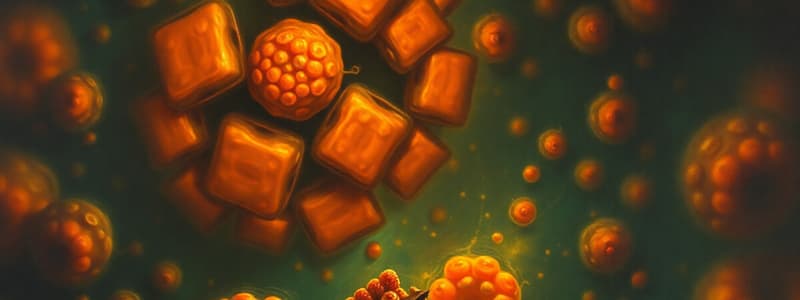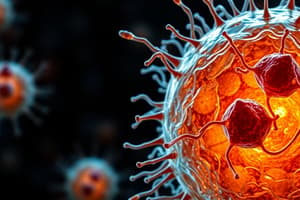Podcast
Questions and Answers
What is a consequence of inadequate turnover of organelles in aging cells?
What is a consequence of inadequate turnover of organelles in aging cells?
- Higher levels of free radicals (correct)
- Increased energy production
- Reduced protein damage
- Increased macroautophagy activity
How does maintained insulin signaling affect macroautophagy in aging cells?
How does maintained insulin signaling affect macroautophagy in aging cells?
- It enhances glucagon activity.
- It decreases mTOR activation.
- It promotes autophagosome formation.
- It inhibits macroautophagy. (correct)
Which diet has been shown to regenerate various cell types and extend longevity in mice?
Which diet has been shown to regenerate various cell types and extend longevity in mice?
- High protein diet
- Low-fat diet
- Caloric excess diet
- Fasting Mimicking Diet (FMD) (correct)
What is a key function of V-ATPase in autophagic processes?
What is a key function of V-ATPase in autophagic processes?
Why might glucagon's stimulatory effect on macroautophagy be compromised in old cells?
Why might glucagon's stimulatory effect on macroautophagy be compromised in old cells?
What effect does a decline in macroautophagy have on aging cells?
What effect does a decline in macroautophagy have on aging cells?
What health benefits were observed in mice fed a Fasting Mimicking Diet?
What health benefits were observed in mice fed a Fasting Mimicking Diet?
What major mechanism is activated by the insulin receptor that affects macroautophagy?
What major mechanism is activated by the insulin receptor that affects macroautophagy?
What role does mTORC1 play in the regulation of protein synthesis?
What role does mTORC1 play in the regulation of protein synthesis?
Which of the following components is not part of the mTORC1 complex?
Which of the following components is not part of the mTORC1 complex?
How does mTORC1 affect 4EBP in regards to mRNA translation?
How does mTORC1 affect 4EBP in regards to mRNA translation?
Which of the following is a regulator of mTORC1 activity?
Which of the following is a regulator of mTORC1 activity?
What is the result of mTORC1 signaling to S6K?
What is the result of mTORC1 signaling to S6K?
What class of mRNA does mTORC1 signaling particularly affect based on recent analyses?
What class of mRNA does mTORC1 signaling particularly affect based on recent analyses?
Which amino acid is mentioned as a key regulator of mTORC1 activation?
Which amino acid is mentioned as a key regulator of mTORC1 activation?
What is the function of Ragulator in relation to mTORC1?
What is the function of Ragulator in relation to mTORC1?
What is the primary role of the low pH in lysosomes?
What is the primary role of the low pH in lysosomes?
Which of the following transporters is known for sensing luminal arginine?
Which of the following transporters is known for sensing luminal arginine?
What is the primary role of mTORC1 in cellular processes?
What is the primary role of mTORC1 in cellular processes?
What is one function of mTORC1 in cells?
What is one function of mTORC1 in cells?
Which of the following enzymes is responsible for converting fatty acyl-carnitine back to fatty acyl-CoA?
Which of the following enzymes is responsible for converting fatty acyl-carnitine back to fatty acyl-CoA?
How does cholesterol exit the lysosome?
How does cholesterol exit the lysosome?
In beta-oxidation, how many carbons are processed at a time from fatty acids?
In beta-oxidation, how many carbons are processed at a time from fatty acids?
What potential problem does solute efflux in lysosomes help prevent?
What potential problem does solute efflux in lysosomes help prevent?
In which location do proton-coupled amino acid transporters primarily function?
In which location do proton-coupled amino acid transporters primarily function?
What must occur before fatty acids can undergo oxidation in the mitochondria?
What must occur before fatty acids can undergo oxidation in the mitochondria?
Which effector does mTORC1 directly phosphorylate to promote mRNA translation initiation?
Which effector does mTORC1 directly phosphorylate to promote mRNA translation initiation?
Which of the following components is liberated as a result of mTORC1 signaling?
Which of the following components is liberated as a result of mTORC1 signaling?
What is the effect of S6K1 phosphorylation in the context of protein synthesis?
What is the effect of S6K1 phosphorylation in the context of protein synthesis?
What is the primary product of each round of fatty acid oxidation?
What is the primary product of each round of fatty acid oxidation?
What role does the thiolase enzyme play in fatty acid metabolism?
What role does the thiolase enzyme play in fatty acid metabolism?
Which reaction in beta oxidation is similar to the fumarase reaction of the citric acid cycle?
Which reaction in beta oxidation is similar to the fumarase reaction of the citric acid cycle?
What are the end products after each cycle of fatty acid oxidation?
What are the end products after each cycle of fatty acid oxidation?
What form of fatty acyl-CoA ligase begins the activation of fatty acids?
What form of fatty acyl-CoA ligase begins the activation of fatty acids?
Flashcards
Macroautophagy failure in aging
Macroautophagy failure in aging
Impaired macroautophagy, a cellular recycling process, contributes to aging by reducing the removal of damaged organelles and cellular components.
Autophagic vacuole accumulation
Autophagic vacuole accumulation
Lysosomes failing to fuse with autophagic vacuoles leading to a buildup of undegraded material in aging cells.
Reduced autophagosome formation
Reduced autophagosome formation
Aging cells may not make enough autophagosomes due to decreased activation of macroautophagy by inhibitors such as mTOR.
Organelle turnover
Organelle turnover
Signup and view all the flashcards
Fasting Mimicking Diet (FMD)
Fasting Mimicking Diet (FMD)
Signup and view all the flashcards
Stem cell regeneration
Stem cell regeneration
Signup and view all the flashcards
Low lysosomal pH
Low lysosomal pH
Signup and view all the flashcards
V-ATPase
V-ATPase
Signup and view all the flashcards
Lysosome pH
Lysosome pH
Signup and view all the flashcards
Acid hydrolases
Acid hydrolases
Signup and view all the flashcards
SLC transporters
SLC transporters
Signup and view all the flashcards
SLC38A9
SLC38A9
Signup and view all the flashcards
Lysosomal efflux
Lysosomal efflux
Signup and view all the flashcards
mTORC1
mTORC1
Signup and view all the flashcards
Proton-Coupled Amino acid transporters
Proton-Coupled Amino acid transporters
Signup and view all the flashcards
mTOR activation
mTOR activation
Signup and view all the flashcards
mTORC1's Role in Ribosome Biogenesis
mTORC1's Role in Ribosome Biogenesis
Signup and view all the flashcards
mTORC1's Regulation of Translation
mTORC1's Regulation of Translation
Signup and view all the flashcards
Fatty Acid Transport into Cells
Fatty Acid Transport into Cells
Signup and view all the flashcards
Fatty Acyl-CoA Formation
Fatty Acyl-CoA Formation
Signup and view all the flashcards
Carnitine Shuttle
Carnitine Shuttle
Signup and view all the flashcards
Raptor
Raptor
Signup and view all the flashcards
What does mTORC1 regulate?
What does mTORC1 regulate?
Signup and view all the flashcards
4EBP
4EBP
Signup and view all the flashcards
eIF4F complex
eIF4F complex
Signup and view all the flashcards
How does mTORC1 activate translation?
How does mTORC1 activate translation?
Signup and view all the flashcards
mTORC1 and Ribosome Biogenesis
mTORC1 and Ribosome Biogenesis
Signup and view all the flashcards
How does mTORC1 control translation?
How does mTORC1 control translation?
Signup and view all the flashcards
Fatty Acid Activation
Fatty Acid Activation
Signup and view all the flashcards
Long Chain Fatty Acyl-CoA Ligase
Long Chain Fatty Acyl-CoA Ligase
Signup and view all the flashcards
Beta Oxidation - Reaction 1
Beta Oxidation - Reaction 1
Signup and view all the flashcards
Beta Oxidation - Reaction 2
Beta Oxidation - Reaction 2
Signup and view all the flashcards
Beta Oxidation - Reaction 3
Beta Oxidation - Reaction 3
Signup and view all the flashcards
Study Notes
Week 7, Lecture 11
- Autophagy Failure in Aging: Possible causes and consequences of autophagy failure in old organisms are depicted in a schematic model.
- Autophagic Vacuoles and Lipofuscin: Accumulation of autophagic vacuoles may occur due to the inability of lipofuscin-loaded lysosomes to fuse and degrade sequestered content.
- Macroautophagy Enhancers and Glucagon: The formation of autophagosomes in old cells might be reduced because of the inability of macroautophagy enhancers (like glucagon) to fully activate the pathway. This effect is compromised in aged cells because of maintained negative signalling via the insulin receptor even under baseline conditions.
- Maintaining Insulin Signaling: Maintaining insulin signaling activates mTOR, a key repressor of macroautophagy.
- Inadequate Organelle Turnover: Inadequate turnover of organelles (like mitochondria) in aging cells can increase free radical levels, leading to protein damage.
- Insulin Receptor and Free Radicals: Free radicals can further potentiate inhibitory signalling through the insulin receptor.
- Age-Dependent Decline in Macroautophagy: An age-related decrease in macroautophagy can compromise the energetic balance of aging cells.
- Autophagy and Longevity: Autophagy plays a critical role in maintaining longevity through multiple processes.
- Pro-longevity Mechanisms: Factors like neural protection, cancer blockage, anti-inflammatory signaling, genomic integrity, stem cell rejuvenation, and cellular/tissue homeostasis all contribute to pro-longevity mechanisms.
- Periodic Fasting and Regeneration: Periodic fasting mimicking diets (FMD) in mice promote multi-system regeneration, improving markers for rejuvenation, adiposity, inflammatory diseases, and cognitive function.
- Lipid and Nucleic Acid Synthesis: mTORC1 plays a crucial role in controlling protein, lipid, and nucleic acid synthesis.
- Anabolism and Catabolism: mTORC1 regulates the balance between anabolism and catabolism in response to environmental conditions.
- mTORC1 Substrate: The mTORC1 substrate 4EBP (eukaryotic initiation factor 4E binding protein) is unrelated to S6K1 and interferes with translation.
- Ribosome Production and Regulation: mTORC1 positively regulates ribosomal RNA transcription and protein synthesis as a way to control stimulus like stressors that lead to increased ribosome production.
- mTORC1 Regulation of mRNA Translation: mTORC1 has a key role in regulating mRNA translation by its effect on S6K and 4EBP which affects the biogenesis of ribosomes.
- Amino Acid Sensing and Lysosome: Arginine activation of SLC38A9 triggers the recruitment of mTORC1 to the lysosome surface and activates it in this process.
- Fatty Acid-Carnitine Shuttle: The process of transporting fatty acids into the mitochondria for oxidation (β-oxidation).
- Fatty Acid Pathway Stages: Different stages exist: 1. Oxidation, 2. Hydration, 3. Oxidation, and 4. Cleavage.
- Enzyme Roles in Fatty Acid Oxidation: Enzymes like acyl-CoA dehydrogenase, enoyl-CoA hydratase, and hydroxyacyl-CoA dehydrogenase are vital in fatty acid oxidation, leading to acetyl-CoA, FADH2, NADH generation.
- Fatty Acid Oxidation Reactions: The four beta-oxidation reactions, where each round shortens the fatty acid chain reducing it to acetyl-CoA, also produce FADH2 and NADH.
Studying That Suits You
Use AI to generate personalized quizzes and flashcards to suit your learning preferences.
Related Documents
Description
Explore the effects of autophagy failure in aging organisms, including causes, consequences, and the role of insulin signaling. This quiz addresses key concepts such as the accumulation of autophagic vacuoles and the impact of macroautophagy enhancers like glucagon. Understand the relationship between inadequate organelle turnover and oxidative stress in aged cells.




